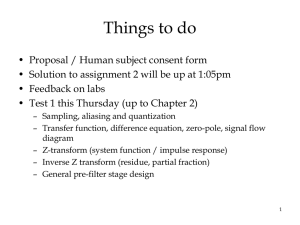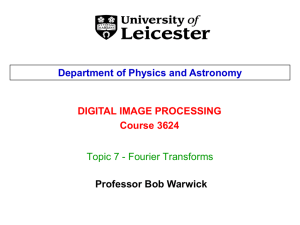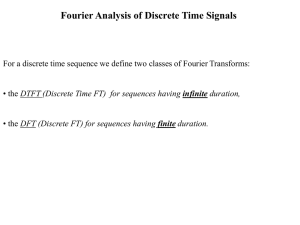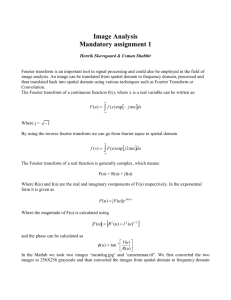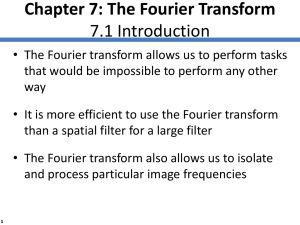On Signal reconstruction from Fourier magnitude
advertisement
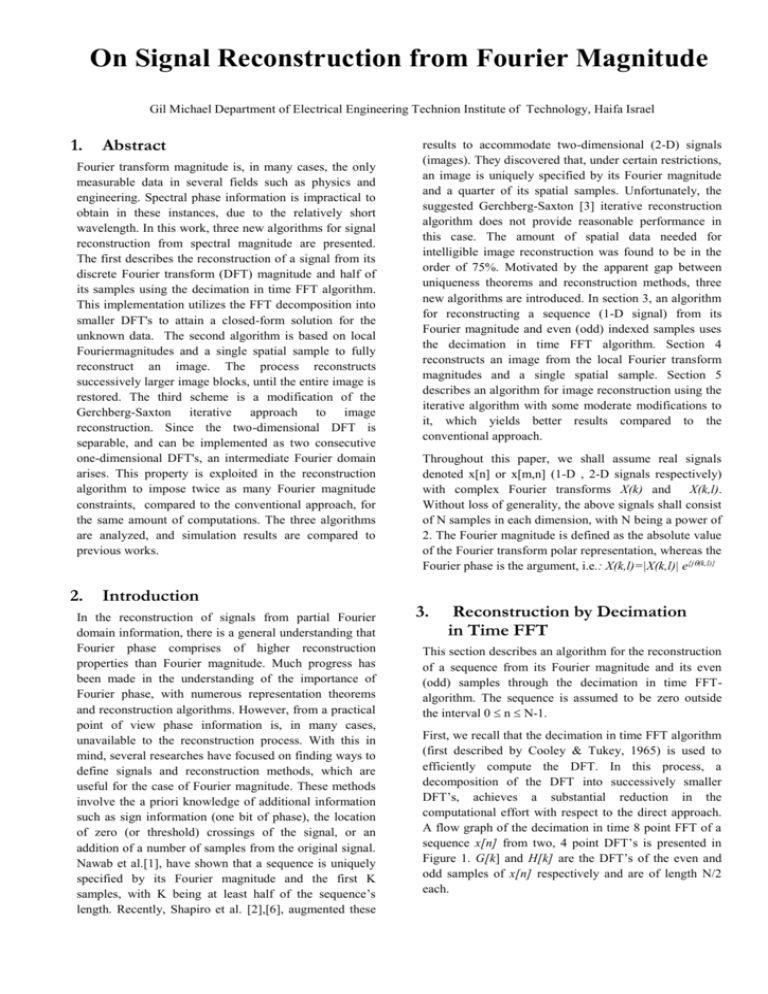
On Signal Reconstruction from Fourier Magnitude
Gil Michael Department of Electrical Engineering Technion Institute of Technology, Haifa Israel
1.
Abstract
Fourier transform magnitude is, in many cases, the only
measurable data in several fields such as physics and
engineering. Spectral phase information is impractical to
obtain in these instances, due to the relatively short
wavelength. In this work, three new algorithms for signal
reconstruction from spectral magnitude are presented.
The first describes the reconstruction of a signal from its
discrete Fourier transform (DFT) magnitude and half of
its samples using the decimation in time FFT algorithm.
This implementation utilizes the FFT decomposition into
smaller DFT's to attain a closed-form solution for the
unknown data. The second algorithm is based on local
Fouriermagnitudes and a single spatial sample to fully
reconstruct an image. The process reconstructs
successively larger image blocks, until the entire image is
restored. The third scheme is a modification of the
Gerchberg-Saxton iterative approach to image
reconstruction. Since the two-dimensional DFT is
separable, and can be implemented as two consecutive
one-dimensional DFT's, an intermediate Fourier domain
arises. This property is exploited in the reconstruction
algorithm to impose twice as many Fourier magnitude
constraints, compared to the conventional approach, for
the same amount of computations. The three algorithms
are analyzed, and simulation results are compared to
previous works.
2.
Introduction
In the reconstruction of signals from partial Fourier
domain information, there is a general understanding that
Fourier phase comprises of higher reconstruction
properties than Fourier magnitude. Much progress has
been made in the understanding of the importance of
Fourier phase, with numerous representation theorems
and reconstruction algorithms. However, from a practical
point of view phase information is, in many cases,
unavailable to the reconstruction process. With this in
mind, several researches have focused on finding ways to
define signals and reconstruction methods, which are
useful for the case of Fourier magnitude. These methods
involve the a priori knowledge of additional information
such as sign information (one bit of phase), the location
of zero (or threshold) crossings of the signal, or an
addition of a number of samples from the original signal.
Nawab et al.[1], have shown that a sequence is uniquely
specified by its Fourier magnitude and the first K
samples, with K being at least half of the sequence’s
length. Recently, Shapiro et al. [2],[6], augmented these
results to accommodate two-dimensional (2-D) signals
(images). They discovered that, under certain restrictions,
an image is uniquely specified by its Fourier magnitude
and a quarter of its spatial samples. Unfortunately, the
suggested Gerchberg-Saxton [3] iterative reconstruction
algorithm does not provide reasonable performance in
this case. The amount of spatial data needed for
intelligible image reconstruction was found to be in the
order of 75%. Motivated by the apparent gap between
uniqueness theorems and reconstruction methods, three
new algorithms are introduced. In section 3, an algorithm
for reconstructing a sequence (1-D signal) from its
Fourier magnitude and even (odd) indexed samples uses
the decimation in time FFT algorithm. Section 4
reconstructs an image from the local Fourier transform
magnitudes and a single spatial sample. Section 5
describes an algorithm for image reconstruction using the
iterative algorithm with some moderate modifications to
it, which yields better results compared to the
conventional approach.
Throughout this paper, we shall assume real signals
denoted x[n] or x[m,n] (1-D , 2-D signals respectively)
with complex Fourier transforms X(k) and X(k,l).
Without loss of generality, the above signals shall consist
of N samples in each dimension, with N being a power of
2. The Fourier magnitude is defined as the absolute value
of the Fourier transform polar representation, whereas the
Fourier phase is the argument, i.e.: X(k,l)=|X(k,l)| e{j(k,l)}
3.
Reconstruction by Decimation
in Time FFT
This section describes an algorithm for the reconstruction
of a sequence from its Fourier magnitude and its even
(odd) samples through the decimation in time FFTalgorithm. The sequence is assumed to be zero outside
the interval 0 n N-1.
First, we recall that the decimation in time FFT algorithm
(first described by Cooley & Tukey, 1965) is used to
efficiently compute the DFT. In this process, a
decomposition of the DFT into successively smaller
DFT’s, achieves a substantial reduction in the
computational effort with respect to the direct approach.
A flow graph of the decimation in time 8 point FFT of a
sequence x[n] from two, 4 point DFT’s is presented in
Figure 1. G[k] and H[k] are the DFT’s of the even and
odd samples of x[n] respectively and are of length N/2
each.
x[0]
x[2]
x[4]
x[6]
G[0]
G[1]
G[2]
G[3]
N/2 Point
FFT
x[1]
x[3]
x[5]
x[7]
W N0
W N1
W N2
W N3
For the retrieval of the phase of H[k], we rewrite X[k] in
the polar form:
(7)
X [k ] X [k ] e jk G[k ] e jk WNk H [k ] e jk 0 k N 2 1
G
H
X [ N k ] G[k ] e jk WNk H [k ] e jk 0 k N 2 1
G
W N0
W N1
W N2
W N3
H[0]
H[1]
H[2]
H[3]
N/2 Point
FFT
X[0]
X[1]
X[2]
X[3]
X[4]
X[5]
X[6]
X[7]
H
Since the sequence x[n] is real, we may use the following
DFT properties:
(8)
X [k ] X [(( k )) N ]
, k (( k ))N
Figure 1: Decimation in Time FFT. Decomposition of an
8-point DFT into two, 4-point DFT’s
G[k ] G[(( k )) N / 2
Following this decomposition, the Fourier transform X[k]
is:
H [k ] H [(( k )) N / 2
(1) X [k ] G[k ] WNk H [k ]
G
, G
k (( k )) N / 2
, kH H
(( k )) N / 2
Where:
Summing & subtracting (7) and applying the properties
of (8):
(2a) G[k ] DFT x even[n]
(9)
(2b) H [k ] DFT xodd [n]
(2c) W Nk e j 2k / N
From Figure 1, it is clear, that given the even samples of
x[n], we can obtain G[k] by simply performing the N/2
point DFT. Hence, the retrieval of the remaining odd
samples of x[n] is equivalent to the reconstruction of
H[k].
We first turn to the retrieval of the magnitude of H[k]:
2k
)
N
2k
H
j X [k ] sin(k ) j G[k ] sin(G
)
k ) j H [k ] sin(k
N
Adding the square products of (9) we have:
(10)
2k
2
X [k ] G[k ] 2 H [k ] 2 2 G[k ] H [k ] cos ( kH kG
)
N
And solving (10), the phase of H[k] follows as:
(11)
The squared magnitude of X[k] is given by:
(3a)
X [k ] X [k ] X [k ] G[k ] H [k ]
2
2
... G[k ] WN k
H [k ] G
2
[k ] WNk
H [k ]
k 0,1,2
N
1
2
Similarly, |X[k+N/2]|2 can be written as:
X [k N / 2] G[k ] H [k ] G[k ] W N k H [k ]
2
2
G [k ] W Nk H [k ]
, k 0,1,2
Where we’ve used the property:
(4) W k N / 2 W k
N
N
The sum and difference of (3a), (3b) give:
(5)
2
N
2
2
] 2 G[k ] H [k ]
2
From (5) we obtain |H[k]|, by:
2
X [k ] X [k
(6)
2/5
2
H [k ]
1
N
2
X [k ] X [k ]
2
2
2
2
G[k ]
X [k ] 2 G[k ] 2 H [k ]
kH a cos
2 G[k ] H [k ]
G
k
(3b)
2
H
X [k ] cos(k ) G[k ] cos(G
k ) H [ k ] cos(k
N
1
2
2k
N
2
0 k N 2 1
From (11) there is an inherent ambiguity in the phase of
HK. This ambiguity is present for each of the samples of
H[k] e.g. – there are 2 solutions for each DFT value of
H[k] and hence 2 solutions for each DFT value of X[k].
The number of possible solutions for X[k] is therefore
2N/4-2 taking into account the properties of (8) and the
fact that H[0] is positive and real (e.g.– Hk = 0).
In order to resolve this ambiguity, we note that when a
2N-point DFT is performed on an N-point sequence (i.e.interpolating the signal in the frequency domain) there is
a unique relationship between the odd and even samples
of the Fourier transform. This relationship between the
DFT samples, X[k], and the interpolated values is
realized in the Fourier domain by the interpolation kernel:
(12)
N 1
1 e jN
k 0
1 WNk e j
X (e j ) 1 N X (k )
For L=2, the even samples of X[k], Xeven are equal to the
N point DFT values of x[n],whereas the odd samples,
Xodd hold the interpolated values, and are equally spaced
around the unit circle at intervals ± from Xeven :
(13)
X odd [l ]
sin( kl )
1 N 1
X even[k ] j X even[k ]
N k 0
1 cos( kl )
;
where :
2 (k l 1 )
2
kl
N
2x2, overlapping by one sample. Note the small
inconsistency in the upper left corner due to the initial
guess.
x(0,0)
X1
X2
X3
From this relationship, a unique solution to X[k] is found,
and hence the reconstruction of the original sequence
x[n].
4.
Reconstruction from Fourier
Magnitude and a Single Spatial
Sample
The uniqueness theorem of representation from Fourier
magnitude and a quarter of the spatial-samples[2],
requires that a large amount of the image must be known
a priori. One may argue, that in many cases the spatial
samples are unavailable, or at most- be only estimates of
the actual spatial samples. In light of this, a proposed
theorem requires a single spatial sample, x(0,0) and local
Fourier magnitudes as follows:
X4
Figure 2: A 16 by 16 point image reconstructed from
local Fourier transform magnitudes with x(0,0) as the
known spatial data. The process first derives the upper
left 2x2 subsection of the image from x(0,0) and the local
Fourier magnitude of X1. This new spatial data and the
local Fourier magnitude |X2| are next used for the
reconstruction of the block of size 4x4. The process is
preformed successively, until the entire image is
recovered.
Theorem1: For N>0, let x(m,n) be a signal that is zero
outside the interval 0≤ n,m <N-1. Let N be a power of 2
such that for some positive number r, N=2r. Suppose
x(0,0) is nonzero, and the matrices Ai are invertible. Then,
|Xi(u,v)| and x(0,0) uniquely specify the entire image
x(n,m), where Ai are the matrices as described in [6], and
|Xi | are the local Fourier magnitudes of the signal. The
local Fourier magnitude is defined as the Fourier
Transform magnitude of a section of the original signal,
xi[m,n], where 0 ≤ n,m < 2i-1.
Proof: From Figure 2, we note that x(0,0) is exactly a
quarter of the spatial samples in x1(m,n). Therefore,
providing that the matrix A1 is invertible [6], the
conditions of theorem 1 of [2] are met and x1(m,n) (2-by 2) is uniquely specified by x(0,0) and |X1|. In the next
stage, x2(m,n) is uniquely specified by |X2| and x1(m,n).
Again, the uniqueness condition must be satisfied by the
invertiblity of A2. This process continues until the full
reconstruction of x(m,n) from |X|=|Xr| and xr-1(m,n), with
N=2 r. As can be seen, a total of r local Fourier
magnitudes are required to uniquely specify the original
image. The only spatial sample used, is x(0,0). Simulation
results show, that even if x(0,0) is chosen arbitrarily,
good results are obtained. Figure 3 is the original image
from which the magnitude was taken. The reconstructed
image (Figure 4) used an arbitrary initial sample and the
local Fourier magnitudes from image sections of size
3/5
Figure 3: Original Image of “Lena”
Figure 4: Reconstruction from localized Fourier
magnitudes and a single spatial sample. The initial
sample x(0,0) was chosen arbitrarily. The local Fourier
magnitudes were taken from image sections of size 2x2,
overlapping by one sample.
5.
Modified Iterative Approach:
The Intermediate Fourier
Domain
The Gerchberg-Saxton algorithm, often used in signal
reconstruction problems, is implemented by iteratively
imposing constraints and known data samples in the
time/spatial or Fourier domains. Although convergence
of this algorithm has not yet been proven, it serves as a
relatively simple and straightforward approach to signal
reconstruction. In the 2-D case, where Fourier magnitude
and spatial samples are available, they are imposed in the
Fourier and spatial domains respectively. In addition, the
finite support of the image is exploited to null any values
outside the region of support in the spatial domain. There
is, however, a method of imposing the spatial constraints
without the actual passing through this domain. We
recall, that the 2-D DFT may be implemented using two
consecutive 1-D DFT’s – one DFT on the rows (columns)
of the image and the other DFT on the resultant matrix
columns (rows). Although not spatial, this intermediate
Fourier domain preserves some of the spatial constraints
– such as nulling of samples outside the region of
support. With this in mind, full image rows and/or
columns are available as known spatial samples, we may
exploit them by simply using their associated 1-D DFT as
the new constraints in the intermediate Fourier domain,
thus
reducing
the
amount
of
computations
required.Figure 5 illustrates the modified iterative
approach. First, the known spatial data (full rows and
columns) is converted to the intermediate Fourier domain
by 1-D DFT’s to produce Xrow and Xcol. Next, the whole
image (unknown data is assumed zero) is converted to the
Fourier domain, by a 2N by 2N DFT. Then, the Fourier
domain constraints are used to impose the magnitude
information, preserving the phase. The iterative
procedure begins with an inverse DFT (1-D IDFT) on
the rows of the Fourier estimate, then imposing Xcol and
nulling half the columns of the result. Next, a 1-D DFT
on the rows returns us to the Fourier domain, where
magnitude constraints are imposed once again. The
resultant matrix columns undergo an inverse DFT, with
the same actions in the intermediate Fourier domain
performed on the rows (imposing Xrow and nulling of
half the rows). The iteration is completed with the 1-D
IDFT on the result, which returns us once more to the
Fourier domain. We note that each iteration has twice as
many magnitude constraints imposed in the Fourier
domain, compared to the classic iterative procedure. An
image reconstructed using this algorithm is presented in
Figure 6. Approximately half of the spatial data was used
and the result was obtained after 100 iterations.
Figure 7 depicts the MSE ratio of the image reconstructed
in Figure 6, for various percentages of known spatial
samples, and after 100 iterations.
4/5
x_temp: K known rows,Kknown columns
X_row=DFT of x_temp rows
X_col=DFT of x_temp columns
X_temp=2-D DFT of x_temp
Impose Fourier magnitude on
X_temp
X_int_r = IDFT{X_temp}on rows
Impose X_col on X_int_r
Null columns N to 2N-1
X_temp = DFT{X_int_r} on rows
Impose Fourier magnitude on
X_temp
X_int_c = IDFT{X_temp} on coluns
Impose X_row on X_int_c
Null rows N to 2N-1
X_temp = DFT{X_int_r} on columns
Figure 5: Intermediate Fourier domain reconstruction
flow graph. The spatial constraints are imposed in this
domain, hence only 1-D Fourier transforms are required
during the process.
Figure 6: Intermediate Fourier domain magnitude
reconstruction of “Lena” after 100 iterations, with 50%
known spatial samples.
[2] Y.
Shapiro
and
M.Porat,
"Image
Representation by Spectral Amplitude:
Conditions for Uniqueness and Optimal
Reconstruction",
IEEE
International
Conference on Image Processing ICIP (1998)
Figure 7: Intermediate Fourier domain magnitude
reconstruction algorithm (solid) vs. the conventional
Gerchberg-Saxton approach (dashed) for various
percentages of known spatial samples. The image of
“Lena” was reconstructed after 100 iterations and the
MSE ratio (dB) was calculated with respect to the
original image.
[3]
R.W. Gerchberg, W.O. Saxton, “A practical
algorithm for the determination of phase from
image and diffraction plane”, Optik, vol. 35
pp. 237-246, 1972
[4]
A.V. Oppenheim, R.W. Schafer “Discrete
Time Signal Processing” Prentice Hall 1989
[5]
A. Yariv, “Optical Electronics”,
Rinehart and Winston, 1991
[6]
Y. Shapiro and M. Porat, "Signal
Reconstruction
from
Partial
Spectral
Information", IEEE International Symposium
ISIE, pp. 482-486, Pretoria, South Africa
(1998).
The solid line describes the performance of the
intermediate Fourier domain iterative approach, in
comparison with the conventional Gerchberg-Saxton
algorithm, where known data was located in an MxM
box, where M is the square root of the number of known
spatial data (dashed). The intermediate Fourier domain
algorithm suggests better performance and produces an
intelligible reconstructed image with as little as 15% of
known spatial data.
6.
Summary
Three new approaches to signal-reconstruction from
Fourier magnitude were presented. A simple and efficient
way of reconstructing a sequence from its Fourier
magnitude information and partial sequence data, using
the decimation in time FFT eliminates convergence
uncertainty in the 1-D iterative approach while reducing
calculations with respect to the direct approach (equation
solving). The second algorithm requires only magnitude
information and a single spatial sample to fully
reconstruct a 2-D signal (image). This may prove useful
in phase retrieval problems where accurate spatial
information is unavailable, whereas Fourier magnitude
may be measured on specific regions of the image.
Finally, a more efficient Gerchberg-Saxton algorithm
utilizes the separability property of the 2-D DFT into two,
1-D DFT’s - thus imposing the Fourier magnitude
constraints at twice the rate of the conventional approach.
7.
References
[1]
S.H. Nawab, T.F. Quatieri and J.S. Lim
“Signal Reconstruction from Short Time
Fourier Transform Magnitude”, IEEE Trans.
On ASSP, ASSP-31, Vol. No. 4, 1983
Rev. Date: 6 February 2016
5/5
Holt

